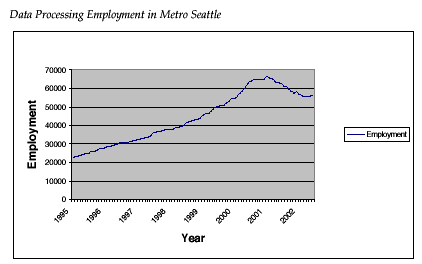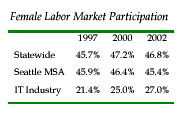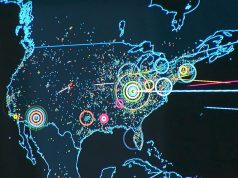9.8.2003
While the public is well informed on the recent boom and bust of Seattle’s high-tech industry, an important part of the picture has faded from popular view. The IT workforce that bore the brunt of this downturn, shedding 10,000 jobs in just one year, has continued to search for footing and face the realities of today’s IT labor market. A new report produced by WashTech, a local affiliate of the Communications Workers of America (CWA) founded in 1998 to address problems faced in today’s high-tech workplaces, examines the present and future prospects of this class of workers. The findings are summarized below.
THOUGH THE BOOM AND BUST IN I.T. EMPLOYMENT WERE BOTH DRAMATIC, THE CURRENT POSITION IS STABLE, IF STAGNANT.

Facts:
· With more than 56,000 employees at last count, the high-tech sector still employs more workers today than it did in the boom year of 1999.
· Rather than a short-term blip on the employment radar, the low employment growth rates for today’s high-tech sector show every sign of persisting.
· The sudden downturn has left Washington’s IT workers with an unemployment rate of 10%, nearly twice that of the statewide industrial average.
WHILE THE OFT-CONJURED IMAGE OF THE MALE, YOUNG AND HIGHLY EDUCATED TECHNICAL EXPERT HAS NEVER BEEN A REALISTIC PICTURE OF THE AVERAGE HIGH-TECH WORKER, TODAY’S IT WORKFORCE IS MOVING FURTHER AWAY FROM THE STEREOTYPE.
Facts:
· Women are gaining steady ground in their IT labor representation.

· IT workers are only slightly younger than the overall workforce.

· Today’s IT workforce is trending towards less education, even as the overall workforce becomes more educated.
Table 7: Difference in College Graduation Rates of Workers Ages 25 and Older

This final statistic can be explained in part by the fact that the most experienced and educated IT workers often move into management, and when downsized have a much greater ability to transition into a management position in another industry.
THERE ARE SIGNIFICANT BARRIERS TO RE-EMPLOYMENT FOR SEATTLE’S CURRENT HIGHTECH WORKFORCE.
Seattle’s IT firms continue to rely heavily on non-permanent job arrangements.
· An overwhelming 96 percent of IT contingent workers surveyed in metro Seattle said they would prefer a standard, full-time job.
· Between 1995 and 2001, 10.8 percent of the Seattle-area IT workforce consisted of contingent workers.
· Beyond the problem of job instability, contingent employment required most of these workers to direct a portion of their take-home pay toward basic fringe benefits. In 2001, just 10.7 percent of metro Seattle’s contingent IT workers received employer-sponsored health insurance.
· Although it might seem that IT firms turn to non-permanent employment during lean times in which full-time jobs are scarce, the opposite is the case. Temporary and contingent workers are hired most aggressively during boom times and used as buffers against sharp economic downturns.
The IT industry is increasing its practice of “offshoring” – shifting significant portions of labor to lower-cost foreign workers, both here and abroad.
· Despite the employment downturn in the IT industry, the annual allocation of H- 1B visas has risen, from 65,000 in fiscal year 1997 to 195,000 in fiscal year 2003. Though intended only for use in the absence of qualified American workers, vague layoff protections and easily skirted standards for prevailing wages have turned these visas into a steady means of procuring lower-cost labor.
· In addition, L-1 visas allow companies to transfer foreign-based workers to their U.S. offices—300,000 to date—potentially displacing domestic labor.
· More than one million IT-related jobs are expected to move out of the U.S. within the next 15 years.
Overall, the current IT workforce is challenged on several fronts, and finds itself younger, less experienced and less educated than during Seattle’s high-tech boom years. In short, these workers are faced with fewer and fewer options for reemployment in other industries.
For a full copy of the report, contact:
Washtech/Communications Workers of America, Local 37083, 2900 Eastlake Avenue East, Suite 200, Seattle, WA 98102. Tel: (206) 726-8580 | Fax: (206) 323-6966
www.washtech.org | E-mail: [email protected] [24×7]


















